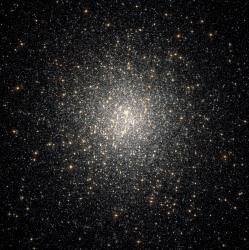Astronomers have long believed that globular star clusters formed out of a single cloud of dust and gas. All the stars in the cluster should be roughly the same age. But new observations from the Hubble Space Telescope show this isn’t always the case – in cluster NGC 2808, there were three distinct periods of star formation.
Globular star clusters are some of the most ancient objects in the Universe, forming shortly after their parent galaxies came together. They’re compact swarms with hundreds of thousands of stars held together by mutual gravity. The traditional view is that these clusters formed together, from the same material, at the same time, and then evolved together over time.
These new Hubble observations show that there are clearly three different populations of stars in globular cluster NGC 2808. All of the stars formed within 200 million years of each other. Each generation contains a different mix of chemicals, with increasing quantities of helium.
One theory is that the clusters hung onto large quantities of gas, beyond that initial period of star formation. Some event, or shockwaves from supernovae might have collapsed this gas, mixing in heavier elements to create additional stars. Another possibility is that NGC 2808 isn’t a globular cluster at all, but an ancient dwarf galaxy that was stripped of most of its material when it was captured by the Milky Way.
Original Source: Hubble News Release

